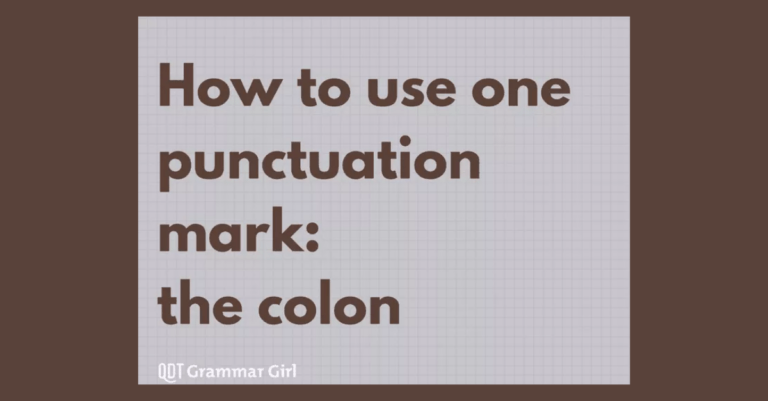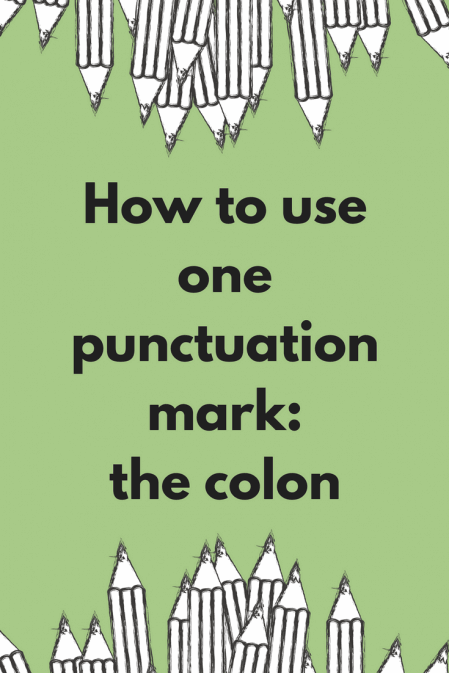- Today’s topic is how to use colons.
One of my favorite old grammar books, titled “Punctuate It Right,” has a wonderful name for the colon: the author calls it the mark of expectation or addition. That’s because the colon signals that what comes next is directly related to the previous sentence. Often, it’s almost a definition of what came before.
Use Colons After Complete Sentences
Style guides differ significantly, however, when it comes to colons, so the most important thing is to know what style guide you should be following and what rules it recommends. The two main rules that differ are whether you can use a colon after a sentence fragment and whether you capitalize the first word after a colon.
If you don’t follow a specific style guide, you can pick the rules that you like best. Just be sure to use them consistently. Making your own personal style sheet is one way to make it easier to be consistent in the future. If you like a style, write it down.
APA Style: Complete Sentences and Capitalization
I’ll start with the style I like best, which is APA style: the style of the American Psychological Association.
- 1) In APA style, you use a colon only after a complete introductory clause. In other words, after only something that could stand on its own as a complete sentence.
Squiggly has one dream: becoming a chocolatier. (correct in APA style)
Squiggly bought: chocolate chips, butter, and a spatula. (incorrect in APA style)
2) In APA style, you capitalize the first word after a colon if it’s the start of at least one complete sentence (or of course, if it’s a proper noun).
Squiggly has one dream: He dreams of becoming a chocolatier. (correct in APA style)
Squiggly has one dream: he dreams of becoming a chocolatier. (incorrect in APA style)
So in APA style, you can use a colon only after a complete sentence, and you capitalize the first word after a colon when it’s the start of a complete sentence.
Chicago Style: Complete Sentences and Less Capitalization
Next, let’s look at the colon rules from the Chicago Manual of Style. They’re similar to APA in that they only allow you to use a colon after something that could stand alone as a complete sentence.
For example, it’s correct to write, “Grammar Girl has two favorite hobbies: watching clouds and seeing how long she can stand on one foot.” That’s correct in Chicago style because “Grammar Girl has two favorite hobbies” is a complete sentence all by itself.
And let’s think for a minute about why we use colons. Why is it appropriate in this sentence?
Notice how the items after the colon expand on or clarify what came before the colon. I referred to my favorite hobbies before the colon and then specifically named them after the colon. A Quick and Dirty Tip for deciding whether a colon is a good choice is to test whether you can replace it with the word “namely.” For example, you could say, “Grammar Girl has two favorite hobbies, namely, watching clouds and seeing how long she can stand on one foot.” Most of the time, if you can replace a colon with the words “namely,” or “it is,” or “they are,” then the colon is the right choice.
Where Chicago differs from APA style is that in Chicago style, you’re only supposed to capitalize the first letter after the colon if it’s the start of at least two complete sentences. If it’s just one sentence in Chicago, you keep the first word lowercase.
Therefore, you’d capitalize the word “she” in the following sentence because it’s the start of a two-sentence series:
Grammar Girl has had many hobbies over the years: She used to love watching clouds. Today, however, she prefers to use colored pencils to fill in all the round letters she finds in magazines.
But in Chicago style, you wouldn’t capitalize “she” in “she used to love watching clouds” if you ended the description of Grammar Girl’s hobbies after “she used to love watching clouds” because then there’s only one sentence after the colon:
Grammar Girl has had many hobbies over the years: she used to love watching clouds. (correct in Chicago style)
Grammar Girl has had may hobbies over the years: She used to love watching clouds. (incorrect in Chicago style)
To summarize, in Chicago style, you use colons only after complete sentences and you capitalize the first word after a colon only if it’s the start of at least two complete sentences or is a proper noun.
AP Style: Sentence Fragments and Capitalization
Finally, let’s look at Associated Press style.
It’s like APA style in that you capitalize the first word after a colon if it’s the start of at least one complete sentence.
The huge difference is that AP colon rules allow you to use a colon after a sentence fragment. Whereas this sentence would be wrong in APA and Chicago style, it’s fine in AP style:
Aardvark’s moods are: grumpy and grumpier. (correct in AP style)
Similarly, if you have a sentence introducing a bulleted list, AP style allows you to put a colon after a sentence fragment like this:
Grammar Girl’s hobbies are:
- skiing
- reading
Because I don’t like this style, I usually add the words “the following” before the colon. (“Grammar Girl’s hobbies are the following:”) It’s an easy way to make a fragment a complete sentence. But introductions to bulleted lists are also the place I see most people break the only-put-a-colon-after-a-complete-sentence rule, even if they follow it everywhere else. I know it looks wrong to a lot of people to have a line before a bulleted list without a colon at the end, so a lot of you probably like this style from AP. And that’s fine. You can like it.
To summarize, AP style lets you put a colon after a sentence fragment or a complete sentence, and you capitalize the first word after a colon if it’s the start of at least one complete sentence or is a proper noun.
Space After a Colon
Fortunately, there are at least a couple of colon rules on which all these three style guides agree:
First, put one space after a colon.
People often argue about how many spaces to put after a period (the short answer is that one space is more common these days), and the problem also comes up with colons. When people used typewriters, the style was to put two spaces after a colon; but now that almost everyone uses computers with word processing software, the common style is to put one space after a colon just as you would for a period.
Colons After Short Introductory Words
Second, colons are fine after short introductory words or phrases like “pros” and “cons” that are more like titles than sentences, and after names of people in a dialogue or transcript of a conversation. (AP and Chicago allow it. As far as I can tell, APA doesn’t address it, but I suspect it would be OK.)
Squiggly: Where is the chocolate I ordered for my truffles?
Aardvark: I think Fenster ate it.
Squiggly: Fenster has been out of town for a week.
Aardvark: Has he? Interesting.
Colons in Non-Sentence Usages
Colons are also used in some instances that aren’t sentences such as Bible verses, time, and citations:
John 1:1
12:30 p.m.
5:43 (indicating volume 5, page 43 in Chicago style)
Create a Personal Style Sheet
As you can see from going over all these conflicting styles, there’s a good reason to decide which style you like best and write it down in a personal style sheet. If you read a lot, you’ll probably see colons handled differently every day, so it’s easy to get confused about which rules to follow, and being consistent in your own writing is one thing that makes it look more professional to readers.
Mignon Fogarty is Grammar Girl and the founder of Quick and Dirty Tips. Check out her New York Times best-seller, “Grammar Girl’s Quick and Dirty Tips for Better Writing.”





